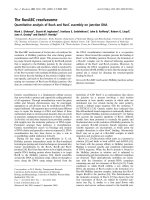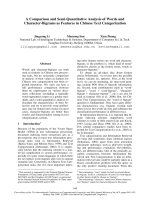ADVANCES IN QUANTITATIVE ANALYSIS OF FINANCE AND ACCOUNTING Volume 6 pot
Bạn đang xem bản rút gọn của tài liệu. Xem và tải ngay bản đầy đủ của tài liệu tại đây (1.96 MB, 270 trang )
6741 tp.indd 1 2/1/08 9:14:26 AM
ADVANCES IN QUANTITATIVE ANALYSIS OF
FINANCE AND
ACCOUNTING
vOLUME 6
This page intentionally left blankThis page intentionally left blank
N E W J E R S E Y
•
L O N D O N
•
S I N G A P O R E
•
B E I J I N G
•
S H A N G H A I
•
H O N G K O N G
•
TA I P E I
•
C H E N N A I
World Scientic
Editor
Cheng-Few Lee
Rutgers University, USA
Volume 6
6741 tp.indd 2 2/1/08 9:14:30 AM
ADVANCES IN QUANTITATIVE ANALYSIS OF
FINANCE AND
ACCOUNTING
British Library Cataloguing-in-Publication Data
A catalogue record for this book is available from the British Library.
For photocopying of material in this volume, please pay a copying fee through the Copyright
Clearance Center, Inc., 222 Rosewood Drive, Danvers, MA 01923, USA. In this case permission to
photocopy is not required from the publisher.
ISBN-13 978-981-279-168-9
ISBN-10 981-279-168-X
Typeset by Stallion Press
Email:
All rights reserved. This book, or parts thereof, may not be reproduced in any form or by any means,
electronic or mechanical, including photocopying, recording or any information storage and retrieval
system now known or to be invented, without written permission from the Publisher.
Copyright © 2008 by World Scientific Publishing Co. Pte. Ltd.
Published by
World Scientific Publishing Co. Pte. Ltd.
5 Toh Tuck Link, Singapore 596224
USA office: 27 Warren Street, Suite 401-402, Hackensack, NJ 07601
UK office: 57 Shelton Street, Covent Garden, London WC2H 9HE
Printed in Singapore.
Advances in Quantitative Analysis of Finance and Accounting – Vol. 6
ADVANCES IN QUANTITATIVE ANALYSIS OF FINANCE AND ACCOUNTING
PohHoon - Advs in Quan Vol 6.pmd 5/20/2008, 6:40 PM1
February 18, 2008 16:14 spi-b567 Advances in Quantitative Analysis of Finance and Accounting: Vol.6 fm
Preface to Volume 6
Advances in Quantitative Analysis of Finance and Accounting is an annual
publication designed to disseminate developments in the quantitative analy-
sis of finance and accounting. The publication is a forum for statistical and
quantitative analyses of issues in finance and accounting as well as applica-
tions of quantitative methods to problems in financial management, financial
accounting, and business management.The objective is to promote interaction
between academic research in finance and accounting and applied research in
the financial community and the accounting profession.
The chapters in this volume cover a wide range of topics. In this volume
there are 12 chapters, three of them are corporate finance and debt manage-
ment: 1. Collateral Constraints, Debt Management, and Investment Incen-
tives, 2. Thirty Years of Canadian Evidence on Stock Splits, Reverse Stock
Splits, and Stock Dividends,and3. Corporate Capital Structure and Firm
Value: A Panel Data Evidence From Australia’s Dividend Imputation Tax
System. There are two of the other nine chapters which cover earnings man-
agement: 1. Why is the Value Relevance of Earnings Lower for High-Tech
Firms? and 2. Earnings Management in Corporate Voting: Evidence from
Anti-Takeover Charter Amendments.
Three of the other seven chapters discuss equity markets: 1. Evaluating
the Robustness of Market Anomaly Evidence, 2. Intraday Volume–Volatility
Relation of the DOW: A Behavioral Interpretation,and3. Determinants of
Winner–Loser Effects in National Stock Markets. Two of the other four chap-
ters analyze options and futures: 1. The Pricing of Initial Public Offerings: An
Option Apporach and 2. The Momentum and Mean Reversion Nikkei Index
Futures: A Markov Chain Analysis.
The remaining two chapters are related to portfolio diversification and
quadratic programming: 1. A Concave Quadratic Programming Marketing
Strategy Model with Product Life Cycles and 2. Corporate Capital Structure
and Firm Value: A Panel Data Evidence from Australia’s Dividend Imputation
Tax System. In sum, this annual publication covers corporate finance and debt
management, earnings management, options and futures, equity market, and
portfolio diversification. Therefore, the material covered in this publication is
very useful for both academician and practitioner in the area of finance.
v
February 18, 2008 16:14 spi-b567 Advances in Quantitative Analysis of Finance and Accounting: Vol.6 fm
This page intentionally left blankThis page intentionally left blank
February 18, 2008 16:14 spi-b567 Advances in Quantitative Analysis of Finance and Accounting: Vol.6 fm
Contents
Preface v
List of Contributors ix
Chapter 1 Collateral Constraints, Debt Management,
and Investment Incentives 1
Elettra Agliardi and Rainer Andergassen
Chapter 2 A Concave Quadratic Programming Marketing
Strategy Model with Product Life Cycles 15
Paul Y. Kim, Chin W. Yang, Cindy Hsiao-Ping Peng
and Ken Hung
Chapter 3 Evaluating the Robustness of Market Anomaly Evidence 27
William D. Brown Jr., Erin A. Moore and
Ray J. Pfeiffer Jr.
Chapter 4 Why is the Value Relevance of Earnings Lower
for High-Tech Firms? 49
B. Brian Lee, Eric Press and B. Ben Choi
Chapter 5 Thirty Years of Canadian Evidence on Stock Splits,
Reverse Stock Splits, and Stock Dividends 83
Vijay Jog and PengCheng Zhu
Chapter 6 Intraday Volume — Volatility Relation of the DOW:
A Behavioral Interpretation 117
Ali F. Darrat, Shafiqur Rahman and Maosen Zhong
Chapter 7 The Pricing of Initial Public Offerings: An Option
Approach 127
Sheen Liu, Chunchi Wu and Peter Huaiyu Chen
vii
February 18, 2008 16:14 spi-b567 Advances in Quantitative Analysis of Finance and Accounting: Vol.6 fm
viii Contents
Chapter 8 Determinants of Winner–Loser Effects
in National Stock Markets 143
Ming-Shiun Pan
Chapter 9 Earnings Management in Corporate Voting:
Evidence from Antitakeover Charter Amendments 159
Chun-Keung Hoi, Michael Lacina and
Patricia L. Wollan
Chapter 10 Deterministic Portfolio Selection Models,
Selection Bias, and an Unlikely Hero 179
Herbert E. Phillips
Chapter 11 Corporate Capital Structure and Firm Value:
A Panel Data Evidence from Australia’s Dividend
Imputation Tax System 205
Abu Taher Mollik
Chapter 12 The Momentum and Mean Reversion of Nikkei
Index Futures: A Markov Chain Analysis 239
Ke Peng and Shiyun Wang
Index 253
February 18, 2008 16:14 spi-b567 Advances in Quantitative Analysis of Finance and Accounting: Vol.6 fm
List of Contributors
Chapter 1
Elettra Agliardi
Department of Economics
University of Bologna
P.zza Scaravilli 2, 40126 Bologna (Italy)
Tel: +39 0512098668
Email:
Rainer Andergassen
Department of Economics
University of Bologna
P.zza Scaravilli 2, 40126 Bologna (Italy)
Tel: +39 0512098666
E-mail:
Chapter 2
Paul Y. Kim
College of Business Administration
Clarion University of Pennsylvania
Clarion, PA 16214
Tel: (814) 393-2630
Fax: (814) 393-1910
Email:
Chin W. Yang
College of Business Administration
Clarion University of Pennsylvania
Clarion, PA 16214
Tel: (814) 393-2609
Fax: (814) 393-1910
Email:
ix
February 18, 2008 16:14 spi-b567 Advances in Quantitative Analysis of Finance and Accounting: Vol.6 fm
x List of Contributors
Cindy Hsiao-Ping Peng
Yu Da College of Business, Taiwan
Tel: 011886 34226134
Email:
Ken Hung
Department of Finance
National Dong Hua University
Hua-lien, Taiwan
Tel: 360 715 2003
Email:
Chapter 3
W illiam D. Brown, Jr.
Department of Business Administration
Stonehill College
Easton, MA 02357
Tel: (508) 565-1256
Fax: (508) 565-1444
Email:
Erin A. Moore
Department of Accounting
College of Business and Economics
Lehigh University
621 Taylor Street
Bethlehem, Pennsylvania 18015-3117
Tel: (610) 758-4962
Fax: (610) 758-6429
Email:
February 18, 2008 16:14 spi-b567 Advances in Quantitative Analysis of Finance and Accounting: Vol.6 fm
List of Contributors xi
Ray J. Pfeiffer, Jr.
Isenberg School of Management
Department of Accounting and Information Systems
University of Massachusetts
Amherst, Massachusetts 01003
Email:
Tel: (413) 545-5653
Fax: (413) 545-3858
Chapter 4
B. Brian Lee
College of Business
P.O. Box 519, MS-2310
Prairie View A&M University
Prairie View, TX 77446
Tel: 936.261.9258
Email:
Eric Press
Fox School of Business
335 Speakman Hall
Temple University
Philadelphia, PA 19122
Tel: 215.204.8127
Email:
B. Ben Choi
91-1712 Newton Street
Victoria, BC V8R 2R2
Tel: 250.598.8717
February 18, 2008 16:14 spi-b567 Advances in Quantitative Analysis of Finance and Accounting: Vol.6 fm
xii List of Contributors
Chapter 5
Vijay Jog
Professor of Finance
Eric Sprott School of Business
Carleton University
1125 Colonel By Drive
Ottawa, Ontario, Canada, K1S 5B6
Tel: (613) 520-2600 Ext. 2377
Email:
PengCheng Zhu
Ph.D. candidate
Eric Sprott School of Business
Carleton University
Email:
Chapter 6
Ali F. Darrat
Department of Economics and Finance
Louisiana Tech University
Ruston, LA 71272
Shafiqur Rahman
School of Business Administration
Portland State University
P. O. Box 751
Portland, OR 97207-0751
Tel: (503) 725-3715
Fax: (503) 725-5850
Email:
Maosen Zhong
UQ Business School
The University of Queensland
Brisbane, QLD 4072, Australia
February 18, 2008 16:14 spi-b567 Advances in Quantitative Analysis of Finance and Accounting: Vol.6 fm
List of Contributors xiii
Chapter 7
Sheen Liu
Faculty of Finance
Washington State University–Vancouver
Vancouver, WA 98686
Tel: 360 546-9516
Fax: 360 546-9037
Chunchi Wu
Lee Kong Chian School of Business
Singapore Management University
50 Stamford Road
#04-01 Singapore 178899
Email:
Peter Huaiyu Chen
Department of Accounting and Finance
Youngstown State University
One University Plaza
Youngstown, OH 44555
Tel: 330 941-1883
Email:
Chapter 8
Ming-Shiun Pan
Department of Finance and Supply Chain Management
Shippensburg University
Shippensburg, PA 17257
Tel: 717-477-1683
Fax: 717-477-4067
Email:
February 18, 2008 16:14 spi-b567 Advances in Quantitative Analysis of Finance and Accounting: Vol.6 fm
xiv List of Contributors
Chapter 9
Chun-Keung Hoi
Rochester Institute of Technology
106 Lomb Memorial Drive
Rochester, NY 14623-5608
Phone: (585)-475-2718
Fax: (585)-475-6920
Email:
Michael Lacina
University of Houston-Clear Lake
2700 Bay Area Boulevard
Houston, TX 77058-1098
Tel: (281) 283-3171
Fax: (281) 283-3951
Email:
Patricia L. Wollan
Rochester Institute of Technology
106 Lomb Memorial Drive
Rochester, NY 14623-5608
Phone: (585)-475-4419 (Phone)
Fax: (585)-475-6920 (Fax)
Email:
Chapter 10
Herbert E. Phillips
Professor of Finance
Fox School of Business and Management
Temple University
Philadelphia, Pennsylvania 19122
Tel: 215 204 8141
Email:
February 18, 2008 16:14 spi-b567 Advances in Quantitative Analysis of Finance and Accounting: Vol.6 fm
List of Contributors xv
Chapter 11
Abu Taher Mollik
(PhD) Applied Finance
School of Commerce
University of South Australia
GPO Box 2471
Adelaide SA 5001, Australia
Tel: +61 8 8302 0526
Fax: +61 8 8302 0992
Email: or
Chapter 12
Ke Peng
School of Management
University of Bradford
Emm Lane, Bradford
BD9 4JL, United Kingdom
Tel: +44 (0)1274 234352
Email:
Shiyun Wang
China Finance Data Center
Southwestern University of Finance and Economics
610074, P. R. China
Tel: +86 (0)28 87099197
Email:
February 18, 2008 16:14 spi-b567 Adva nces in Quantitative Analysis of Finance and Accounting: Vol.6 edtbd
Advances in Quantitative Analysis of Finance and Accounting
Editorial Board
Mike J. Alderson University of St. Louis, USA
James S. Ang Florida State University, USA
K. R. Balachandran New York University, USA
Thomas C. Chiang Drexel University, USA
Thomas W. Epps University of Virginia, USA
Thomas J. Frecka University of Notre Dame, USA
Robert R. Grauer Simon Fraser University, Canada
Puneet Handa University of lowa, USA
Der-An Hsu University of Wisconsin, Milwaukee, USA
Prem C. Jain Georgetown University, USA
Jevons C. Lee Tulane University, USA
Wayne Y. Lee Kent State University, USA
Scott C. Linn University of Oklahoma, USA
Gerald J. Lobo University of Houston, USA
Yaw Mensah Rutgers Unversity, USA
Thomas H. Noe Tulane University, USA
Thomas Noland University of Houston, USA
Fotios Pasiouras University of Bath, UK
Oded Palmon Rutgers University, USA
Louis O. Scott Morgan Stanley Dean Witter, USA
Andrew J. Senchak University of Texas, Austin, USA
David Smith Iowa State University, USA
K. C. John Wei Hong Kong Technical University, Hong Kong
William W. S. Wei Te mple University, USA
Chunchi Wu Syracuse University, USA
Uzi Yaari Rutgers University, USA
February 19, 2008 10:10 spi-b567 Advances in Quantitative Analysis of Finance and Accounting: Vol.6 ch01
Chapter 1
Collateral Constraints, Debt Manage ment,
and Investment Incentives
Elettra Agliardi and Rainer Andergassen
University of Bologna, Italy
This chapter analyses the hedging decisions of an emer ging economy which is exposed to
market risks and whose debt contract is subject to collateral constraints. Within a sovereign debt
model with default risk and endogenous collateral, the optimal choice of hedging instruments
are studied when both futures and nonlinear derivati ves are available. It is examined in which
way the hedging policy is a ffected by the cost of default and t he financial constraints of the
economy and some implications are provided in terms of resource allocation.
Keyw ords: Hedging strategies; financial constraints; default cost; endogenous collateral;
emerging markets.
1. Introduction
Emerging markets have been exposed to remarkable market risks and it is by
now folk wisdom that, if given a choice, they should be endowed with instru-
ments of hedging against downside risks (see Caballero, 2003; Caballero and
Panageas, 2003; Shiller, 2003). Finding out which factors are the fundamen-
tal source of volatility for each country — for example, the prices of oil for
Mexico, of coffee for Brazil, of semiconductors for Korea, of copper for Chile,
and so on — is recognized as a crucial step in order to construct the appro-
priate hedging instruments, which will be contingent on observable variables
(Caballero, 2003). Yet, it remains to be answered the question concerning the
proper application of derivative securities that can be used to construct hedg-
ing strategies and the optimal hedging policy. The purpose of this chapter is
to examine the hedging decisions of an economy which is exposed to market
risks and is subject to collateral constraints. The model considered here is a
sovereign debt one, with default risk and endogenous collateral.
Collateral is typically used to secure loans. Since the article by Kiyotaki
and Moore (1997), it has been pointed out that if collateral is endogenous,
then the debt capacity of firms is altered, causing fluctuations in output
(Krishnamurthy, 2003). In this chapter, a model is discussed where the use of
1
February 19, 2008 10:10 spi-b567 Advances in Quantitative Analysis of Finance and Accounting: Vol.6 ch01
2 E. Agliardi & R. Andergassen
hedging instruments may affect collateral values and thus, the debt capacity
of the debtor.
In most literature relating to the 1980s debt c risis and following the Bulow
and Rogoff models (1989, 1991), a given proportion of output or exports are
assumed to be available for repayment of outstanding debt. This means that
repayment is modeled as an output tax and actual repayment is the minimum
of this amount and debt. Alternatively, in other models (Eaton and Gersowitz,
1981; Eichengreen, 2003; Thomas, 2004) a fixed sanction is established in the
case of default, which is not a direct claim on the country’s current resources
and is not received by the creditors, but may represent the future losses due
to diminished reputation. In this chapter, a model is developed where the
amount of repayment by the debtor country is determined endogenously by an
optimizing choice of the debtor and where the two above mentioned aspects of
the repayment contract are present. Indeed, the debt contract is a collateralized
one, where profits on internationally tradable goods can be used forrepayment,
constituting the endogenous collateral; additionally, in the case of default, a
sanction is imposed which affects nontradable goods, which represents the
cost to the debtor of defaulting. Within this framework, hedging may be driven
by the desirability to reduce expected default costs. As Smith and Stulz (1985)
have shown, by hedging a debtor is able to reduce the likelihood of default by
increasing the income it gets in the downside.
The present chapter is most related to the literature on risk management.
Recently, a few articles have studied the optimal choice of hedging instruments
of a firm when either futures or options are available. It has been shown that in
the model of competitive firms with output price uncertainty, where all input
decisions are made simultaneously prior to resolution of uncertainty, hedging
with futures does provide a perfect hedge and there is no scope for nonlinear
instruments such as options as pure hedging instruments. Albuquerque (2003)
characterizes optimal currency hedging in three cases, namely in the presence
of bankruptcy costs, with a convex tax schedule, and in the case of a loss-averse
manager. In all these cases, he shows that futures dominate options as hedging
instruments against downside risk. Batterman et al. (2000) study the optimal
choice of hedging instruments of an exporting firm exposed to exchange rate
risk, when both currency futures and standard options are available. They
show that the hedge effectiveness of futures is larger than that of options.
Wong (2003) studies the optimal hedging decision of an exporting firm
which faces hedgeable exchange rate risk and nonhedgeable price risk, when
February 19, 2008 10:10 spi-b567 Advances in Quantitative Analysis of Finance and Accounting: Vol.6 ch01
Collateral Constraints, Debt Management, and Investment Incentives 3
price and exchange rate risk have a multiplicative nature. This source of non-
linearity creates a hedging demand for nonlinear payoff currency options dis-
tinct from that for linear payoff currency futures. Moschini and Lapan (1992)
analyze the problem of hedging price risk under production flexibility, yield-
ing nonlinearity of profits in output price, and show that there is a role for
options even when the use of futures is allowed. In Froot et al. (1993) it is
shown that firms may decide not to hedge fully, if there is correlation between
investment opportunities and the availability of funds; moreover, options may
be needed in addition to futures to implement the optimal hedge when there
are state-dependent financing opportunities.
In this chapter optimal investment and hedging decisions are characterized.
It is shown that the decision to use nonlinear hedging strategies in addition
to futures contracts can be optimal in relation to market conditions and finan-
cial constraint of the economy. In particular, it is shown in which way the
optimal hedging decision is affected by the cost of default. In addition to a
short position in futures, either concave or convex hedging with options is
optimal, depending on the size of default costs. In particular, it is found that
if default costs are sufficiently large, options are used for financing purposes,
that is, to increase financial resources when these are needed for investment
purposes. If default costs are sufficiently low, options are employed for spec-
ulative motives, i.e., financial resources are reduced when they are needed for
investment purposes. The present results are thus closely related to those of
Adam (2002, 2004) who shows how firms employ nonlinear hedging strategies
to match financial resources against financial needs at different time periods.
The remainder of the chapter is organized as follows. Section 2 describes
the model and the hedging problem of the economy. Section 3 contains the
optimal hedging choices of a futures and straddles. Section 4 concludes. All
proofs are in the Appendix.
2. The Model
The model is a two-period model of sovereign debt with default risk.
1
Con-
sider an economy having access to a technology producing an internationally
tradable and a nontradable good, denoted by y
T
and y
NT
, respectively. In the
1
For a survey of the literature about sovereign debt, see Eaton and Fernandez (1995), in Hand-
book of International Economics, Grossman and Rogoff (eds.). Amsterdam: Elsevier.
February 19, 2008 10:10 spi-b567 Advances in Quantitative Analysis of Finance and Accounting: Vol.6 ch01
4 E. Agliardi & R. Andergassen
production quasifixed inputs (e.g., capital goods) and variable inputs (e.g.,
labor) are used. The economy has no initial endowments. Thus, in order to
produce, firms have to borrow capital from abroad. Borrowing is done with
collateralized one-period-ahead debt contract in order to purchase and use in
the production functions k + z units of capital, where k and z are the units
of capital employed in the production of y
NT
and y
T
, respectively. Only the
internationally tradable good can be used as a collateral.
At time 1 the price of the internationally tradable good p is not known
with certainty and the economy must commit to production plans by choosing
the level of investment z and k in capital goods. The price of the nontradable
good is known, constant over time.
In what follows, it is assumed that at time 1 producers can take positions in
the futures market and in the option market to hedge their exposure. At time 2
uncertainty is resolved and the economy chooses the level y
T
(y
NT
) conditional
on z (k) and on the open futures and options positions determined at time 1.
The risk free interest rate is normalized to 0.
2.1.
Time 2
At time 2, when price uncertainty is resolved, the usual profit maximization
yields:
g(z, p) = max
y
T
{py
T
− c
1
(y
T
, z)}
where c
1
(y
T
, z) is the variable costfunction which is conditionalonthe levelof
z. In what follows, it is assumed that the production function is y
T
=
˜
Az
β
2
L
1
2
,
where L is labor and 0 <β<1. Therefore, g(z, p) = p
2
Az
β
.
It is assumed that in the case of default, a sanction is imposed exogenously
which leads to a reduction of (1−˜α)% of nontradable goods, with 1 ≥˜α>0.
Let q be the constant price of the nontradable good. The production problem
of the nontradable good y
NT
at time 2 is given as follows:
φ
1
(k) = max
y
NT
qy
NT
− c
2
(y
NT
, k)
in case of no default
φ
2
(k, ˜α) = max
y
NT
˜αqy
NT
− c
2
(y
NT
, k)
in case of default
where c
2
(y
NT
, k) is a twice continuously differentiable function with positive
first and second derivative in y
NT
and c
2
(0, k) = 0 . To simplify the exposition,
the following production function y
NT
=
˜
Bk
1−η
L
η
has been considered,
February 19, 2008 10:10 spi-b567 Advances in Quantitative Analysis of Finance and Accounting: Vol.6 ch01
Collateral Constraints, Debt Management, and Investment Incentives 5
where 1 >η>0, and consequently φ
1
(k) = Bk and φ
2
(k,α) = α Bk,with
α = (q ˜α)
1
1−η
, 1 ≥ α>0.
Consumption occurs in period 2. Consumers are risk-neutral and gain
utility just from the consumption of the nontradable good. Thus , maximiz ing
aggregate utility corresponds to maximizing k.
2.2.
Time 1
At time 1 the country borrows from foreign creditors funds to purchase and
use k + z units of capital. Since there are only two periods, the loan has to
be paid back at time 2. All debt contract has to be collateralized. Let r be
the repayment price per unit of capital. Let x represent the futures position
(x > 0 is short) and s the straddle
2
position (s > 0 is short) that firms take to
hedge the risk associated with price uncertainty. Denote the random profit of
the economy at time 1 by:
π(p) = p
2
Az
β
−rz −rk + ( f − p)x + (t − v)s (1)
where f = E (p), t = E(|p − p
∗
|),andv =|p − p
∗
|,wherep
∗
is the strike
price. Then, the collateral constraint requires π(p) ≥ 0. Notice that for s > 0,
i.e., a short position in straddles, the economy increases its financial resources
available for investment in the first period at the cost of reducing them in the
second period, while for s < 0, i.e., a long position in straddles, the opposite
occurs. Since in the present model the economy has no initial endowments,
for s > 0 straddles are used for financing purposes since shortening straddles
reduces financial constraints in the first period where investment decisions
have to be taken. For s < 0 straddles are used for speculative purposes since
financial resources are reduced when these are needed for investment pur-
poses, while financial constraints are alleviated in the second period when
repayments are due. The same argument holds true for short and long posi-
tions in futures.
Gi ven the collateral constraint, at time 1 when the price uncertainty has
not been solved yet, the problem is specified as follows:
max
k,z,x,s
(k,α,χ)≡ Bk[1 − (1 −α)(1 − χ)] (2)
2
A long/short straddle is a portfolio which consists of a long/short put and a long/short call on
the same asset with the same strike price and exercise time.
February 19, 2008 10:10 spi-b567 Advances in Quantitative Analysis of Finance and Accounting: Vol.6 ch01
6 E. Agliardi & R. Andergassen
where χ =
P
I
π(p)≥0
ψ
∗
( p) dp, I
π(p)≥0
is an indicator function, ψ
∗
( p) is
the probability density function of the price of y
T
, defined over the set P .
For simplicity,
3
p = p + ε is defined, where E (ε) = 0 and assume that
ε ∈[−
p, p] and is symmetrically and uniformly distributed, with probability
density function ψ(ε) =
1
2 p
. It is assumed that p
∗
= p. Thus, f = p, t =
p
2
,
and v =|ε|.
2.3.
Benchmark
Consider the case where the price of the collateral is known with certainty,
and equal to its average value, i.e., p =
p,where p = E(p). The problem
reduces to:
max
z
{p
2
Az
β
−rz}
From the first-order condition z
0
=
β
−2
p
A
r
1
1−β
is obtained and thus, optimal
k is obtained from condition π(
p) = 0 which yields k
0
=
1−β
β
z
0
.
3. Optimal Hedging
Since g(z, p) is quadratic in p,
π(ε) =
p
2
Az
β
−r (z + k) +[2 pAz
β
− x]ε + Az
β
ε
2
+
p
2
−|ε|
s
Since ε is symmetrically distributed over the set [−
p, p], π can be rewritten
considering only positive values of ε. Thus, for ε ≥ 0,
π(ε) =
p
2
Az
β
−rz − rk +
p
2
s +[2
pAz
β
− x − s]ε + Az
β
ε
2
π(−ε) = p
2
Az
β
−rz − rk +
p
2
s −[2
pAz
β
− x − s]ε + Az
β
ε
2
The following result can be obtained.
Proposition 1. A short futures position x = g
p
(z, p) = 2 pAz
β
is optimal.
3
The assunptions of a symmetric distribution of prices and of a profit function quadratic in
price is also in Moschini and Laplan ( 1992, 1995), where they show that futures and options
have a role in hedging price risk.
February 19, 2008 10:10 spi-b567 Advances in Quantitative Analysis of Finance and Accounting: Vol.6 ch01
Collateral Constraints, Debt Management, and Investment Incentives 7
Optimality requires a short position in futures equal to 2pAz
β
. Thus,
a short futures position increases the funds available at time 1 for invest-
ment purposes. Moreover, the future position does not depend on the cost of
default α.
For x = 2
pAz
β
,π(−ε) = π(ε) is obtained, where:
π(ε) =
p
2
Az
β
−r (z + k) +
p
2
− ε
s + Az
β
ε
2
π(ε) ≥ 0 for values external to the two roots:
ε
1,2
=
s ±
s
2
− 4 [p
2
Az
β
−r (z + k) +
p
2
s]Az
β
2Az
β
(3)
where δ =
s
s
∗
and s
∗
= pAz
β
. It is assumed that only a finite amount of
straddles are available on the market. This corresponds to imposing upper
and lower bounds on δ, i.e., |δ|≤
δ. To find a solution to problem (2) it
proceeds in two steps. First, using the first-order condition for z, the optimal
level of capital k which yields a given probability of default c is found, where
c ∈[0, 1].Inthiswayk is obtained as a function of c and δ. The payoff
function in (2) can be rewritten as:
(c,δ) = k(c,δ)[1 − (1 − α)c] (4)
In the second step, the optimal position in straddles and the optimal probabil-
ity of default c ∈[0, 1] are found. From (4) it is observed that maximizing the
payoff function with respect to δ reduces to maximizing k(c,δ) over appro-
priate values of δ, for each given c. Subsequently, it can be shown (see the
Appendix) that k(c,δ
∗
),whereδ
∗
is the optimal value of δ, is an increasing
function of c. Thus, in maximizing the payoff function with respect to c,the
economy has to trade-off a larger expected punishment due to default against
larger values of k. The size of the expected punishment depends on the value
of α. The larger this value is, the lower is the punishment in the case of default.
Consequently, the solution to this trade-off depends on the size of α.
The following result can be obtained.
Proposition 2. There exists a critical level α
∗
(β, δ) such that for 0 ≤ α<
α
∗
(β, δ) the optimal choice is δ = 1 and c = 0, while for α
∗
(β, δ) < α ≤ 1
the optimal choice is δ =−δ and c ∈ (
1
2
, 1], where α
∗
(β, δ) is a decreasing
February 19, 2008 10:10 spi-b567 Advances in Quantitative Analysis of Finance and Accounting: Vol.6 ch01
8 E. Agliardi & R. Andergassen
function of β and δ and is strictly positive for β<β(δ) and 0 otherwise,
where β
(δ) < 0.
Proposition 2 states that optimality requires nonlinear hedging. For s uf-
ficiently low values of α, i.e., sufficiently large costs of default, optimality
requires a short position of s
∗
≡ pAz
β
straddles. Moreover, in this regime, the
economy is induced never to default. The intuition for this result is as follows.
Short selling straddles increases financial resources a vailable for investment
in the first period while it increases financial constraints in the second period.
Thus, if default costs are sufficiently large, borrowing constraints are tighter,
and thus the economy uses straddles to reduce these constraints in the first
period and chooses not to default. Thus, in this regime straddles are used for
financing purposes. For sufficiently large values of α, i.e., sufficiently low
costs of default, optimality requires a long position of s =−
δ pAz
β
.More-
over, in this regime, the economy is induced to default with a probability
larger than
1
2
. In this regime default costs are low and consequently financial
constraints in the first period and borrowing constraints are loose. Thus, in
this regime straddles are employed for speculative motives and furthermore
the country will default with a probability larger than
1
2
.
Thus, the event of default can be avoided for β<β(δ), chosing a n α lower
than α
∗
(β, δ).
Corollary 1. The optimal investment in k is an increasing function of α.
The above mentioned optimal hedging strategies have direct implication
in terms of resource allocation for the economy. It is straightforward to prove
the f ollowing.
Corollary 2. There is overinvestment in k , z with respect to the benchmark
case.
4. Conclusion
This chapter shows how financially constrained economies should hedge. It
thus extends the literature on risk management that shows why firms hedge
and which are the optimal hedging instruments, and the contributions on
emerging markets, which point out that if collateral is endogenous, then the
debt capacity of an economy is altered.









